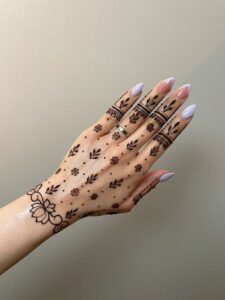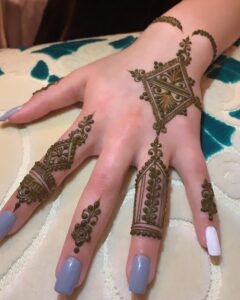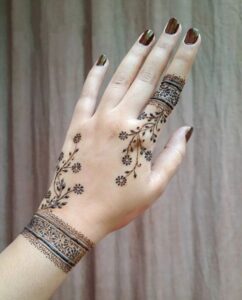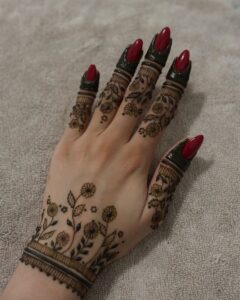Back Hand Mehndi Design
Back hand Mehndi design has become a favorite among women for their graceful, photogenic appeal. Unlike front-hand designs, which are often dense and symbolic, back-hand designs focus on visible beauty, symmetry, and statement patterns. Whether you’re dressing up for a wedding, Eid, Diwali, or just want a fashionable look for a party, the back of the hand offers a perfect canvas for creativity.
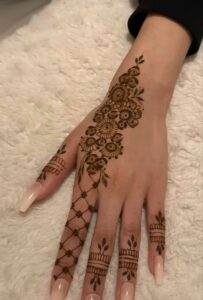
What Makes Back Hand Mehndi Unique?
Back-hand Mehndi designs are typically more structured and geometric, often crafted to complement rings and bracelets. The design may extend from the fingers to the wrist and sometimes even the forearm. These styles are known for their versatility, suitable for both minimal and heavy looks.
Popular Elements in Back Hand Mehndi:
- Floral trails – Flow from fingers to wrist elegantly.
- Mandala patterns – Placed at the center for balance.
- Bracelet or bangle style – Circular designs around the wrist.
- Net (jali) patterns – Add a touch of royal charm.
- Ring-style finger designs – Connected by delicate chains to wrist motifs.
Types of Backhand Mehndi Designs
- Minimalist Modern – Sleek lines, tiny flowers, and dots.
- Traditional Heavy – Full coverage with paisleys and latticework.
- Arabic Fusion – Bold floral trails and lots of negative space.
- Bridal Back Hand – Dense patterns matching the bridal attire.
- Jewelry Style – Looks like wearing hand accessories.
Best Occasions to Apply Backhand Mehndi
- Weddings (as a bride or guest)
- Religious festivals like Eid, Karva Chauth, or Diwali
- Engagement ceremonies
- Photoshoots and special events
- Every day fashion styling
FAQs About Back Hand Mehndi Design
How is backhand Mehndi different from front hand?
Back-hand designs focus more on visible elegance and are often more structured, while front-hand designs tend to be denser and traditional.
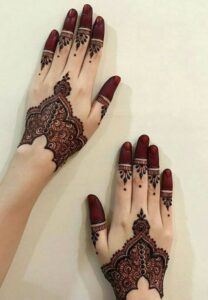
Can I combine different styles in my back-hand Mehndi?
Absolutely! Many people mix Arabic, Indian, and modern elements to create unique hybrid designs.
Is back-hand Mehndi suitable for casual wear?
Yes! You can opt for simple and elegant patterns that suit everyday looks without being too heavy.

How long does back-hand Mehndi take to apply?
A basic design may take 20–30 minutes, while detailed bridal designs can take up to 2 hours.
How can I make my back-hand Mehndi last longer?
Avoid washing your hands for 6–8 hours after application, apply lemon-sugar solution, and use natural oils like clove or coconut after the Mehndi flakes off.
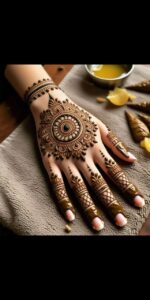
Traditional Pattern Categories
Paisley Perfection
The paisley, or mango motif, forms the foundation of many traditional mehndi designs. This teardrop-shaped pattern symbolizes fertility and life, making it perfect for bridal mehndi. Paisley designs can be simple single motifs or complex arrangements featuring multiple sizes and orientations.
Traditional paisley work often includes intricate fill patterns using dots, lines, and small geometric shapes. The outer edges typically feature delicate curves that flow naturally with the hand’s contours, creating designs that feel organic and balanced.
Floral Fantasies
Floral motifs represent nature’s beauty and life’s continuous renewal. Rose patterns symbolize new beginnings, while lotus designs represent purity and spiritual awakening. Traditional floral mehndi often combines different flower types within a single design, creating gardens of symbolism on the skin.
Classic floral arrangements typically feature a central bloom surrounded by smaller flowers, leaves, and connecting vines. These designs work particularly well on palms, where the natural lines of the hand complement the organic flow of botanical elements.
Sacred Mandalas
Circular mandala patterns hold spiritual significance in many cultures, representing wholeness and the universe’s infinite nature. Traditional mandala mehndi begins with a central point and radiates outward in symmetrical patterns, often incorporating religious symbols or meaningful motifs.
These designs require patience and precision, making them popular choices for special occasions when time allows for detailed application. The meditative process of creating mandalas adds another layer of meaning to the art form.

